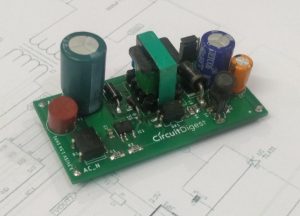A crude way to power your DC circuits with AC mains is to use a step-down transformer for stepping down the 230V mains voltage and adding a couple of diodes as a bridge rectifier. But due to the huge space size and other drawbacks, it cannot be used for all purposes. Another most popular and professional way is to use Switch Mode Power Supply Circuits for converting your AC mains into a wide range of DC voltage as required, almost every consumer electronics from normal 12V adapter to a Laptop Charger has a SMPS circuit to provide the required DC output power.

At circuitdigest, we have already built few popular SMPS circuits for different ratings, namely the 12V 1A Viper 22A SMPS, 5V 2A SMPS, and 12V 1A SMPS circuit each of which can be used for different applications. This time, we will build a SMPS that can be used for general purposes and has a simple module shape to be used in space-related situations. Nowadays, the Internet of Things uses various wifi-based processors like NodeMCU, ESP32, and ESP12E, etc. which operate on 5V or 3.3V. These modules are highly compact and hence to power these boards, it makes sense to use smaller SMPS circuits that can go on the same board, instead of using a separate SMPS circuit. Hence in this article, we will learn how to build a SMPS circuit that can either output 5V or 3.3V (hardware configurable using jumper), the circuit design and PCB layout is also provided, so you can simply port this into your existing design. Here our PCB boards are manufactured by PCBGoGo, a china based low cost high quality PCB prototype and PCB assembly service company.
The rating of the SMPS is 5V or 3.3V 1.5A as most of the development board uses 5V or 3.3V logic level voltages and 1.5A should be good enough for most of the IoT based applications. But do note that this SMPS does not have any filters in the input section to reduce size and cost. Therefore, this SMPS can be only used for powering microcontroller boards or charging purposes. Make sure that it will be covered from the user’s reach when in operation.
Warning: Working with SMPS circuits can be dangerous as it involves AC mains voltage which is potentially lethal. Do not attempt to build this if you have no experience working with AC mains. Always stay cautious with live wires and charged capacitors, use protective tools and supervision if required. You have been warned!!
5V/3.3V SMPS Board Specifications
The SMPS will have the following specifications.
- 85VAC to 230VAC input.
- 5V or 3.3V selectable 2A output.
- Open frame construction
- Short circuit and Overvoltage protection
- Small size with low-cost features.
Materials Required for SMPS Circuit (BOM)
- Fuse 1A 250VAC Slow Blow
- Diode Bridge DB107
- 10uF / 400V
- P6KE Diode
- UF4007
- 2Meg – 2 Pcs – 0805 package
- 2.2nF 250VAC
- TNY284DG
- 10uF / 16V – 0805 package
- PC817
- 1k – 0805 package
- 22R – 2pcs – 0805 package
- 100 nF – 0805 package
- TL431
- SR360
- 470pF 100V – 0805 package
- 1000uF 16V
- 3.3uH – Drum core
- 2.2nF 250VAC
Note: All parts were selected to be easily available for designers. The SMPS transformer has to be custom build using this datasheet. You can either use a vendor to built one or design and wind your SMPS transformer using the link.
This SMPS is designed using power integration IC TNY284DG. This SMPS Diver IC is best suitable for this SMPS as the IC is available in SMD package as well as the wattage is suitable for the purpose. The below image is showing the wattage specification of TNY284DG.
As we can see, TNY284DG is perfect for our option. As the construction is an open frame, it will match the output wattage of 8.5W. Meaning it can easily provide 1.5A at 5V.
5V/3.3V SMPS Circuit Diagram
Construction of this SMPS is pretty simple and straight forward. This design uses the Power Integration chipset as a SMPS driver IC. The schematic of the circuit can be seen in the below image-
Construction and Working
Before going straight into building the prototype part, let’s explore the circuitry operation. The circuit has the following sections-
- Input Protection
- AC-DC conversion
- Driver circuitry or Switching circuit
- Under-voltage lockout protection.
- Clamp circuit
- Magnetics and galvanic isolation
- EMI Filtering
- Secondary Rectifier and snubber circuit
- Filter Section
- Feedback section.
Input Protection
F1 is a slow blow fuse that will protect the SMPS from high load and fault conditions. The SMPS input section does not use any EMI filter considerations. This is a 1A 250VAC slow blow fuse and that will protect the SMPS in fault conditions. However, this fuse can be changed to a glass fuse. You can also check out the article on different types of fuse.
AC-DC Conversion
B1 is the diode bridge rectifier. This is DB107, a 1A 700V diode bridge. This will convert the AC input to the DC voltage. Additionally, the 10uF 400V capacitor will be essential for rectifying the DC ripple and it will provide a smooth DC output to the driver circuit as well as the Transformer.
Driver Circuitry or Switching Circuit
It is the main component of this SMPS. The transformer’s primary side is properly controlled by the switching circuit TNY284DG. The switching frequency is 120-132 kHz. Due to this high switching frequency, smaller transformers can be used.
Source: Design your own Compact 5V 3.3V SMPS Circuit for Embedded and IoT Projects
The post Design your own Compact 5V/3.3V SMPS Circuit for Embedded and IoT Projects appeared first on PIC Microcontroller.
from Blog – PIC Microcontroller https://ift.tt/2S4UvSh


No comments:
Post a Comment
Please do not enter any spam link in the comment box.